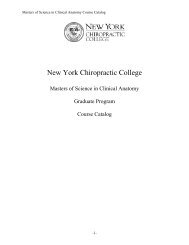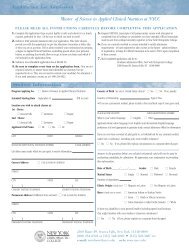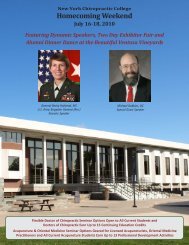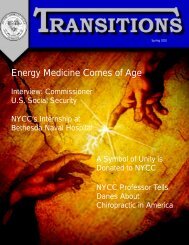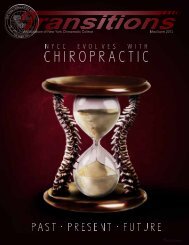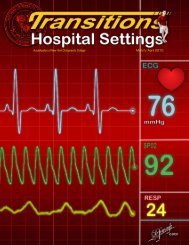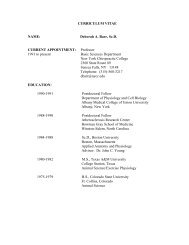July - August 2012 (PDF Version) - New York Chiropractic College
July - August 2012 (PDF Version) - New York Chiropractic College
July - August 2012 (PDF Version) - New York Chiropractic College
Create successful ePaper yourself
Turn your PDF publications into a flip-book with our unique Google optimized e-Paper software.
Alumni Spotlight<br />
Chronic Pain among Veterans Presents Unique Challenges for<br />
<strong>Chiropractic</strong>: Andrew Dunn, DC (NYCC ’99) on Caring for Veterans<br />
Dr. Andrew Dunn, who treats injured veterans in his capacity as Staff Chiropractor at<br />
VA Western <strong>New</strong> <strong>York</strong> Healthcare System, shared some of his thoughts.<br />
Dr. Dunn finds musculoskeletal complaints<br />
to be common among veterans<br />
regardless of the recentness of their<br />
military service. “Not surprisingly,” he<br />
says, “the majority of our consult requests<br />
are for back pain.” Among more recent<br />
veterans, however, co-morbid conditions<br />
such as post-traumatic stress disorder<br />
(PTSD), traumatic brain injury (TBI), and<br />
depression may influence Dunn’s case<br />
management.<br />
Recognizing certain commonalities<br />
among patients whose response to treatment<br />
was limited, Dunn was curious<br />
to know the extent to which certain<br />
co-morbid conditions might influence<br />
clinical outcomes. “There are a number<br />
of well-founded theories that explain<br />
how chronic-pain complaints could be<br />
perpetuated or otherwise influenced by<br />
behavioral health issues,” he said. “We<br />
also noticed difficulties in managing patients<br />
who had issues with obesity, had<br />
reduced conditioning, and expressed<br />
fear-avoidance behaviors with regard to<br />
movement for fear of further injury.” It<br />
was important to convince the patient<br />
that he or she could begin moving and<br />
exercising with a focus on function over<br />
pain: “Providing pain management and<br />
instructions on self-care measures while<br />
validating the nature of their complaints<br />
and providing encouragement can be a<br />
powerful combination.”<br />
In an effort to better understand<br />
patient outcomes Dunn took part in a<br />
number of research studies. He was<br />
aware that although quality-assurance<br />
data was regularly tracked to assess clinic<br />
performance, the process for performing<br />
research within the VA was highly detailed<br />
and regulated, with proposals submitted<br />
to the Institutional Review Board<br />
for consideration, and then carried out<br />
based upon the requirements and rules<br />
of research within VA.<br />
Asked what his research revealed,<br />
Dunn responded, “The take-away message<br />
is that no one provider type can<br />
adequately address the diverse needs<br />
of chronic-pain patients with complex<br />
presentations. It is essential that chiropractors<br />
recognize the significance<br />
of co-morbid conditions and how they<br />
may influence clinical outcomes. Most<br />
importantly, develop a network of providers<br />
including specialists in behavioral<br />
health for referral or co-management as<br />
appropriate.”<br />
While the role of chiropractic in treat-<br />
Dr. Andrew Dunn (NYCC '99)<br />
ing men and women in the military and<br />
after their discharge has yet to be fully<br />
defined, Dunn believes that chiropractors<br />
who can appreciate the responsibilities of<br />
working within a larger healthcare system<br />
and find ways to add value to that system<br />
are well-suited to work within veterans’<br />
healthcare. “Value is defined not by the<br />
individual provider, but by the system;<br />
and those providers focused on making<br />
meaningful contributions to the mission<br />
of that system should be successful. “<br />
21



